Designing a Small Bathroom with a Jacuzzi Tub
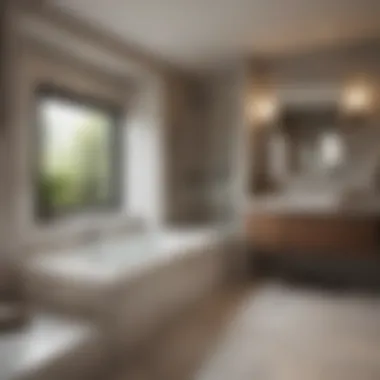
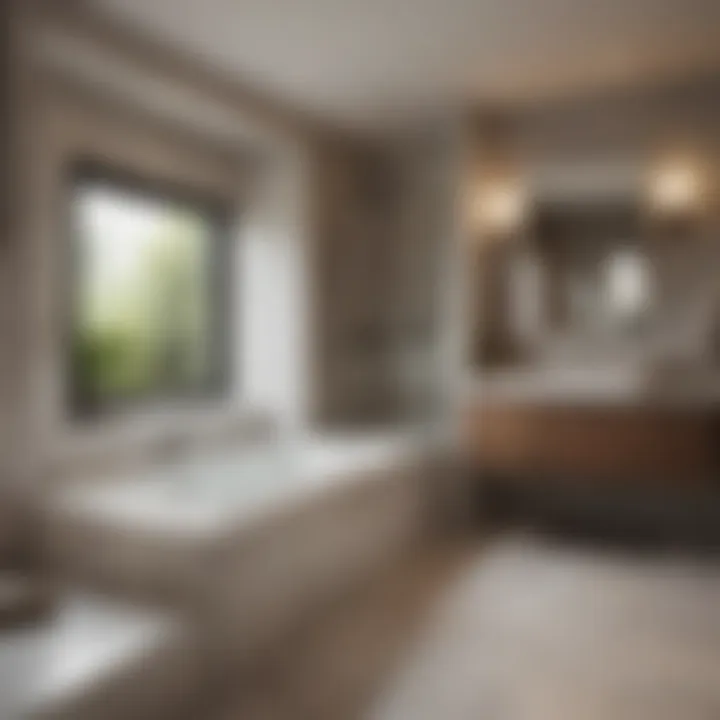
Intro
Creating a sanctuary in a small bathroom can seem impossible, especially if you're considering adding a jacuzzi tub. However, with thorough planning and innovative design, it is entirely feasible to integrate such an indulgent feature into a compact space. This guide will explore key aspects worth considering, such as optimizing layout, selecting materials, and balancing aesthetics with functionality. The end goal is to develop a serene atmosphere, even with limited square footage.
In this article, we will cover various influential design inspirations and practical tips that cater to homeowners and design enthusiasts alike. Let us start by exploring the inspirations that set the tone for your bathroom project.
Design Inspiration
Current Interior Design Trends
When planning your small bathroom, it is essential to stay current with design trends. Minimalism remains a strong influence, emphasizing clean lines and uncluttered spaces. Floating vanities or wall-mounted cabinets can create an illusion of more floor space. Moreover, natural materials like wood and stone are gaining popularity, as they add warmth and texture.
As small bathrooms often lack direct sunlight, incorporating elements like large mirrors can reflect light and enhance the room's brightness. Using compact jacuzzi tubs designed for small spaces allows for indulgence without compromising spatial integrity.
Color Palettes and Their Effects
Color selection plays a significant role in creating a cohesive design. Light colors such as soft whites, gentle blues, and light grays can make a space feel larger and more open. They reflect light better, enhancing the airiness of your small bathroom. In contrast, darker shades can create a cozy, intimate atmosphere, but must be used judiciously to avoid overwhelming the space.
Additionally, consider incorporating accents in complementary colors to add personality without crowding the design. Stronger hues can be applied to the towels or decorative accessories to keep the overall look fresh yet inviting.
A well-chosen color palette can transform perception of space and enhance mood, making a small bathroom feel more comfortable.
This guide will proceed to explore practical aspects of installing a jacuzzi tub in a small bathroom, from layout optimization to choosing suitable materials.
Prelude to Small Bathrooms and Jacuzzi Tubs
Small bathrooms often pose significant design challenges, especially when integrating a luxury element like a jacuzzi tub. This guide addresses the nuances of creating a small bathroom that does not sacrifice style or comfort. Homeowners face the dual task of maximizing limited space while incorporating elements of relaxation and indulgence that a jacuzzi tub represents.
Jacuzzi tubs have gained popularity not just for their luxurious appeal but also for their therapeutic benefits. They provide a serene retreat from the busy world and can significantly enhance the overall experience of a bathroom. By emphasizing well-thought-out design choices, homeowners can create a functional yet inviting environment. The allure of having a personal spa experience at home makes these tubs a coveted feature of many small bathrooms.
The emphasis of this article lies in bridging the gap between luxury and practicality. Specific considerations must be kept in mind ranging from layout optimization to aesthetic choices. Homeowners should focus on how these factors work together to create a seamless design while accommodating a jacuzzi tub in a compact space.
The Appeal of Jacuzzi Tubs
When considering a small bathroom, the appeal of jacuzzi tubs becomes evident for several reasons. First and foremost, they serve as a focal point. A jacuzzi tub can transform an otherwise ordinary space into a luxurious oasis. The functionality of the jets contributes to relaxation, making it a desirable addition for those seeking self-care practices at home.
Moreover, jacuzzi tubs come in various sizes and shapes, making them versatile for different layouts. They can fit into corners or along walls, maximizing available space. This adaptability is vital when working within the constraints of a small bathroom. Additionally, incorporating a jacuzzi tub enhances property value. Real estate trends indicate that homes with well-designed bathrooms yield higher market appeal.
Other factors worth considering include energy efficiency and water conservation. Many modern jacuzzi tubs are designed to maintain heat efficiently and can reduce energy consumption over time. The integration of such features not only provides luxury but also aligns with sustainable practices.
Understanding Spatial Challenges
In small bathrooms, space is a precious commodity. Understanding the spatial challenges is crucial when incorporating a jacuzzi tub. The first challenge lies in measurement. Homeowners need to calculate the exact dimensions of the bathroom to ensure the tub fits comfortably without overwhelming the area. This process includes considering other fixtures such as sinks, toilets, and cabinets that must coexist harmoniously.
Additionally, the principles of layout design become more critical in small spaces. Effective placement strategies involve analyzing traffic flow and creating an efficient layout that allows easy access to all areas of the bathroom. Keeping pathways clear enhances usability while providing a sense of openness.
Lastly, the vertical space must also be maximized. Using wall-mounted storage solutions or tall cabinets can help free up floor space, achieving a balance between functionality and comfort. This way, despite spatial constraints, the bathroom can remain organized and inviting.
Key Insight: Properly understanding and utilizing available space transforms a small bathroom into a functional and luxurious environment.
Designing the Layout
When considering a small bathroom with a jacuzzi tub, the layout becomes pivotal. Smart design ensures efficient use of limited space, while also marrying function with aesthetic appeal. An effective layout can transform a cramped area into a serene retreat, overcoming the inherent challenges of size by focusing on practical solutions.
Measuring Available Space
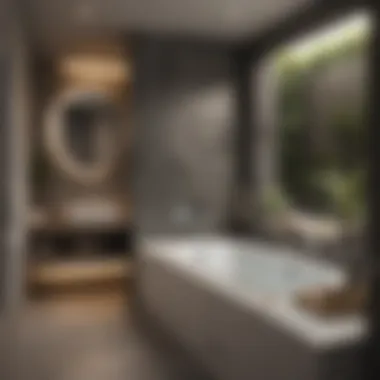
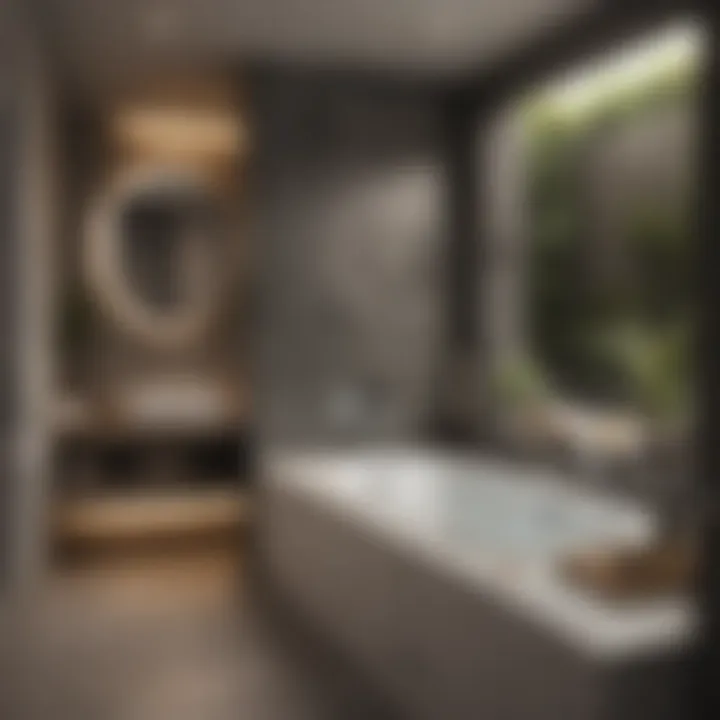
Before any fixture or fitting can be planned, accurate measurements are essential. This step goes beyond the basic dimensions of the room; one must account for existing windows, doors, and plumbing connections. The goal is to find the optimal spot for the jacuzzi tub while ensuring sufficient space for movement and additional fixtures.
A good rule of thumb is to leave at least 24 inches of clearance around the tub. Consider the following points when calculating your available space:
- Room Dimensions: Length and width should be measured to confirm the space.
- Ceiling Height: If your bathroom has a low ceiling, a larger tub could overwhelm the space.
- Natural Light: Identify how windows affect light, as a brighter space may feel larger.
Incorporate these measurements into a sketch or use design software to visualize your layout. This representation aids in planning the tub's location and will help streamline the next phases of the project.
Placement Strategies for Jacuzzi Tubs
Finding the ideal placement for a jacuzzi tub in a small bathroom is essential for both functionality and relaxation. The location should consider both plumbing and usage. Evaluate the following strategies:
- Adjacent Walls: Positioning the tub against a shorter wall can create additional space, making the room feel larger.
- Corner Installation: If floor space is limited, a corner installation can optimize the area available, installing the tub snugly in a corner.
- Freestanding Models: Freestanding tubs often provide flexibility in placement, allowing for creative design and unexpected angles.
Remember to visualize how everyone will move in the space. The tub should not obstruct pathways to other fixtures such as the toilet or sink. This careful consideration enhances the overall user experience.
Integrating Fixtures and Functionality
Once the jacuzzi tub's location is established, integrating surrounding fixtures is the next step. Fixtures must complement the tub, contributing to an organized and coordinated aesthetic. Key elements include:
- Sinks and Vanities: Their placement should not crowd the tub. Leave enough room for both comfort and visual appeal.
- Storage Solutions: Incorporate shelving or cabinetry that allows for easy access to bath essentials, without hindering other functionalities in the room.
- Lighting: Strategically placed lights can enhance ambiance, ensuring the space feels inviting, particularly around the tub area.
Adopting a holistic view during this phase enables a seamless and balanced environment, combining luxury with practicality. It’s vital to design not just for beauty but also for everyday usability.
"Proper planning transforms the layout from a challenge into an opportunity for creativity."
By meticulously designing the layout of a small bathroom with a jacuzzi tub, one can maximize every square inch, embracing both comfort and sophistication.
Aesthetic Considerations
Aesthetic considerations play a crucial role in designing a small bathroom that includes a jacuzzi tub. The visual appeal directly affects the overall experience and functionality of the space. By focusing on aesthetics, homeowners can create an environment that is not only luxurious but also harmonious in design. This can enhance the feeling of space, making a small bathroom seem larger and more inviting. It is essential to consider how color, materials, and lighting will interact within the confined space, creating a cohesive look that maximizes comfort and usability.
Choosing the Right Color Palette
Selecting the right color palette is vital in making a small bathroom feel spacious and inviting. Lighter colors tend to reflect more light, making the room appear larger. Soft whites, pale blues, and light grays can create a calming atmosphere that complements the relaxation provided by a jacuzzi tub. Contrasting accents, like deeper hues in towels or decor, can add depth and interest without overwhelming the space.
To create a monochromatic look, choose different shades of the same color. This technique provides visual unity and can effectively simplify design elements. Alternatively, using complementary colors can create a vibrant yet balanced effect. However, it is important to avoid overly dark tones, as they can close in the space and create a sense of clutter.
Selecting Materials and Textures
Material selection significantly impacts the aesthetic and functionality of a small bathroom. Porcelain tiles, for example, are a popular choice for the flooring and wall coverings due to their durability and variety of designs. Natural stone, while slightly more expensive, offers a luxurious feel that can elevate the appearance of the bathroom.
Incorporating textures can add depth to the design. For instance, a smooth surface of a jacuzzi tub may contrast well with woven baskets or plush towels. Textured wall panels can also invoke a feeling of richness without consuming visual space. Additionally, consider using materials that reflect light, such as glass or glossy finishes, which can assist in brightening up the area.
Lighting Strategies for Ambiance
Lighting is a key element in achieving the desired ambiance in a small bathroom. Layers of lighting can be effective, combining ambient, task, and accent lighting. Recessed lighting or wall sconces can provide general illumination without taking up space. It's also prudent to install dimmers on light switches, allowing homeowners to adjust brightness according to their mood and usage.
Consider adding decorative fixtures or fixtures with a special design to serve as focal points. Warm lighting can foster a cozy atmosphere, while cooler lights can create a more modern feel. Natural light, if possible, should not be overlooked. Windows or skylights can dramatically improve the mood and perceived space while providing ventilation.
"Proper lighting not only enhances safety but also elevates the overall appeal of the bathroom, making it an enticing area of relaxation."
In summary, carefully chosen colors, materials, and lighting can transform a small bathroom into a serene oasis. This attention to aesthetic detail enhances both the functionality and experience of the space, ultimately creating a sophisticated environment that makes the jacuzzi tub the centerpiece of relaxation.
Water and Drainage Considerations
The integration of a jacuzzi tub into a small bathroom brings a set of crucial elements that should not be overlooked. Water supply and drainage represent vital considerations that directly impact the functionality and comfort of the space. Addressing these aspects is essential for a successful design that provides a relaxing sanctuary. Inadequate water supply or ineffective drainage can lead to serious inconveniences, turning an intended haven into a source of frustration.
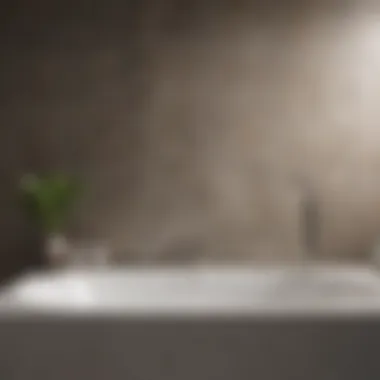

Water Supply Requirements
When planning for a jacuzzi tub, it is important to assess the water supply requirements thoroughly. Most jacuzzi tubs demand a steady flow of water typically ranging from 4 to 14 gallons per minute. To achieve this, homeowners must evaluate their existing plumbing systems. Ensuring your pipes can accommodate the necessary water pressure and volume is essential. Considerations include:
- Pipe Size: The diameter of the water lines is crucial. Larger pipes allow for better flow, minimizing the time needed to fill the tub.
- Water Heater Capacity: Depending on the tub's size and desired temperature, it is necessary to ensure that the water heater can provide enough hot water without long waits.
- Shut-off Valves: Install shut-off valves close to the tub for easy maintenance in case of any leaks or issues.
It’s also advisable to consult with a professional plumber, who can identify any potential changes needed. Modifying your plumbing may seem daunting, but it can prevent potential problems later.
Drainage Solutions for Small Spaces
Effective drainage is equally important, especially in a compact bathroom where space is limited. Jacuzzi tubs generate a good amount of water and must drain away efficiently to prevent flooding or water damage. Here are some considerations for optimizing drainage:
- Use of P-Traps: A P-trap should be installed to prevent sewer gases from entering the home. This is a critical component for any tub, particularly one that holds water often.
- Floor Drain: Consider creating a floor drain if possible. This backup can help facilitate quick drainage in case of an overflow.
- Slope and Elevation: Ensure that the tub is installed at an appropriate elevation. The plumbing should include a slight slope toward the drain to facilitate swift water movement.
Installing an efficient drainage system may require professional help, especially when dealing with limited spaces. However, ensuring proper drainage will protect your investment and maintain the bathroom's functionality over time.
Takeaway: Water supply and drainage are interconnected aspects that require careful planning. Ignoring these factors can lead to complications that diminish the luxurious experience intended within your new bathroom design.
Storage Solutions
In a small bathroom, efficient storage solutions are crucial. Integrating storage not only enhances the organization of space but also contributes to the overall aesthetic and functionality of the bathroom. Specifically, the choice of storage options can help maximize space and minimize clutter, both of which are essential in a compact environment. This section explores various strategies for incorporating effective storage solutions around a jacuzzi tub in a small bathroom.
Maximizing Vertical Space
One of the most effective ways to increase storage in a small bathroom is to maximize vertical space. Wall-mounted shelves, cabinets, and hooks can offer additional storage without taking up valuable floor space. This approach allows homeowners to keep essential items within easy reach while maintaining a clean and organized appearance.
- Wall-mounted cabinets can provide discreet storage for toiletries, towels, and other bathroom essentials. Opt for designs that blend seamlessly with the bathroom’s decor.
- Open shelving can be used not just for storage, but also for displaying decorative items or plants, which adds a personal touch to the space.
- Hooks and pegs can hold towels and robes, making them easily accessible while saving counter space.
Using the height of the walls for strategy ensures that every inch of the small bathroom is effectively utilized. It makes the space feel larger and enhances the sense of order.
Incorporating Multi-Functional Furniture
Another effective method for improving storage in small bathrooms is through multi-functional furniture. This type of furniture serves more than one purpose, thus optimizing the use of space. For example, a vanity with drawers not only provides a spot for grooming but also offers storage for toiletries and personal items. When selecting multi-functional pieces, consider the following:
- Storage benches can serve as seating while providing hidden compartments for towels or bath supplies.
- Mirrored cabinets can reflect light, making the space appear bigger, while also functioning as storage for items like makeup or medicine.
- Ottomans with internal storage can double as seating or even a place to store extra linens.
These solutions give homeowners the ability to maintain a tidy bathroom without sacrificing comfort or luxury.
"In small spaces, every design element counts; thoughtful storage solutions lead to a harmonious and inviting atmosphere."
Incorporating these storage strategies is vital when designing a small bathroom with a jacuzzi tub. Not only do they address the challenges of limited space, but they also facilitate a more pleasurable experience, enhancing the relaxing environment that a jacuzzi is meant to provide.
Accessibility and Safety Features
Incorporating a jacuzzi tub within a small bathroom requires careful attention to accessibility and safety features. This consideration is not merely a formality; it is integral to ensuring that the space can be enjoyed by all individuals, including those who may have mobility challenges. Enhancing safety and accessibility allows everyone to experience the tranquility that a jacuzzi tub offers, eliminating the risk of accidents while promoting peace of mind. Equally, safety features can enhance the overall aesthetic of the bathroom, blending functionality with style.
Non-Slip Surfaces and Flooring
The choice of flooring is critical in any bathroom, but it takes on heightened significance when water is involved. A jacuzzi tub presents unique challenges since water splashes are inevitable. A bathroom floor should prioritize non-slip surfaces to mitigate the risk of falls.
Benefits include:
- Reducing the likelihood of accidents caused by slippery tiles.
- Enhancing grip in wet conditions, not only around the tub but throughout the bathroom.
- Allowing for design versatility; there are many materials, such as textured vinyl, treated wood, or rubber, that can provide both safety and style.
When selecting non-slip flooring, consider having a slightly rough texture without being uncomfortable underfoot. Options such as porcelain tiles with a matte finish or vinyl products specifically designed for wet environments should be evaluated. Furthermore, it is wise to ensure that small area rugs or mats used around the jacuzzi tub are also non-slip to provide additional safety.
Grab Bars and Other Supports
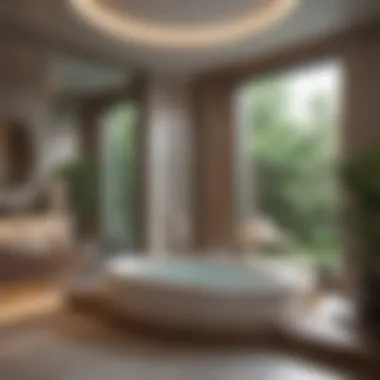

Adding grab bars and other supportive fixtures is an essential measure in making a jacuzzi tub accessible and safe. These features provide users with the stability needed to enter and exit the tub with confidence. They can be installed at strategic points such as the side of the jacuzzi, near the entrance of the bathroom, and next to the toilet.
Key aspects to consider include:
- Material longevity: Stainless steel or durable plastic provide robust options that resist moisture and corrosion.
- Proper installation: These elements should be anchored securely into the wall to bear weight.
- Design integration: Grab bars can be chosen to complement the bathroom’s existing design; they come in various styles and finishes.
The presence of grab bars does not have to diminish the sophistication of your design. They can be stylish yet functional, blending seamlessly into the overall aesthetic of the bathroom while serving a crucial purpose. Additionally, consider adding other supports like a shower seat, which can offer further assistance for individuals who may require rest while bathing.
"Safety and accessibility should be key considerations when designing any bathroom, particularly when elements like a jacuzzi tub are involved. A thoughtful approach not only enhances functionality but also transforms the space into a welcoming environment for everyone."
Cost Considerations and Budgeting
When planning for a small bathroom renovation that includes a jacuzzi tub, cost considerations and budgeting become pivotal steps. The installation of a jacuzzi tub can significantly impact your overall bathroom expenses. Therefore, understanding the various elements related to costs is crucial for homeowners aiming to create a serene, luxurious atmosphere without overspending. This section will detail the financial implications of installing a jacuzzi tub, helping you prepare effectively for the project ahead.
Assessing Installation Costs
Installation costs for a jacuzzi tub can vary greatly depending on numerous factors. Primarily, the complexity of the installation process plays a significant role. If significant plumbing alterations are necessary, these costs can quickly escalate.
- Labor Costs: Hiring professionals is often necessary for installing electrical and plumbing systems safely. This can add considerable expense to the project.
- Preparation Work: Before installation, additional work like removing an old tub or remodeling may be required. This preparation can also increase costs.
It’s essential to get multiple quotes from contractors. This practice ensures a competitive rate and helps identify potential issues with your setup early on. Additionally, consider budgeting for unexpected expenses. Unforeseen complications are common in renovation projects. This might require a buffer in your budget to avoid financial stress.
One common recommendation is to set aside 10-20% of your total budget for unforeseen costs.
Selecting Cost-Effective Materials
Material selection is another crucial aspect of budgeting. Cost-effective materials can achieve an appealing look without sacrificing quality. Here are considerations when selecting materials:
- Tub Options: Choosing a fiberglass or acrylic jacuzzi tub can be more budget-friendly compared to porcelain or cast iron models.
- Tiles and Flooring: Opt for ceramic or vinyl tiles that mimic luxury finishes. These alternatives can enhance aesthetics while keeping costs lower.
- Fixtures and Fittings: Investing in quality fixtures pays off in the long run. Look for deals on brands like Moen and Delta which offer quality at reasonable prices.
Creating a list of materials and their cost estimates is beneficial. Such a list helps you stay on track during the purchasing process, making adjustments as needed to meet your budget. Additionally, frequent sales at home improvement stores can provide opportunities for significant savings.
In summary, transparency in costs along with smart budgeting can create a successful project. Consider both installation and material costs in your financial planning. This strategy will lead you to a well-rounded and effective bathroom renovation.
Culmination and Final Thoughts
Creating a tranquil bathroom with a jacuzzi tub can transform a mundane space into a personal oasis. This comprehensive guide has explored various facets of integrating a jacuzzi tub into a small bathroom, highlighting the significance of both design and practicality. The process involves careful consideration of layout, aesthetics, and functionality. Each of these elements interplays to form a cohesive environment that balances luxury with everyday use.
Optimizing space is a predominant theme in this guide. By measuring dimensions accurately and strategically placing the tub, homeowners can make the most of their limited area. Coupled with the right materials and color schemes, a small bathroom can indeed feel spacious while still providing a sense of seclusion and comfort.
Moreover, safety should never be overlooked. Non-slip surfaces and adequate support features ensure that the bathroom remains safe for all users. These elements not only enhance the usability but also contribute to the sense of peace that a jacuzzi tub can bring.
"A well-designed bathroom is not just a space but an experience that offers relaxation and tranquility."
In summary, the incorporation of a jacuzzi tub invites a plethora of benefits — from improved aesthetics to enhanced functionality. The journey to designing such a space can be both exciting and rewarding, and understanding the key considerations makes it a more accessible goal.
Recap of Key Points
To briefly summarize the significant aspects discussed:
- Layout Optimization: Precise measurements and smart placement of the jacuzzi tub can maximize utility in small spaces.
- Material Selection: Choosing the right materials can enhance the appearance and durability of the bathroom.
- Safety Features: Implementing non-slip surfaces and supportive fixtures ensures a secure environment for all users.
- Aesthetic Choices: A cohesive color palette and appropriate lighting contribute to the overall ambiance of the space.
Incorporating these strategies can significantly improve the usability and beauty of a small bathroom.
Encouragement for Creative Implementation
Homeowners and design enthusiasts should embrace the design process with creativity. Just because space is limited does not mean that it cannot be stylishly functional. Experimenting with different styles, textures, and colors can yield surprising results.
Consider utilizing innovative storage solutions to maintain an uncluttered look. Multi-functional furniture also provides practical benefits while contributing to the overall aesthetic of the bathroom.
Additionally, don't shy away from unique lighting designs to highlight the jacuzzi tub as a focal point. Soft, ambient lighting can create a serene atmosphere that complements the luxurious experience of a bathtub spa.
Remember that each decision made should reflect personal taste and lifestyle needs. A well-designed bathroom should resonate with its users, offering both functionality and a sense of personal retreat.















